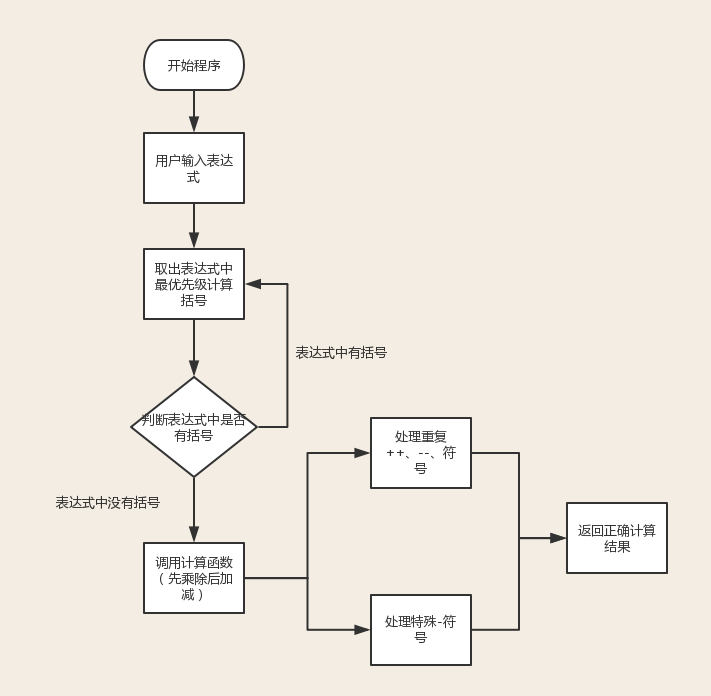一 实现功能
1、实现加减乘除及拓号优先级解析
2、用户输入
1 - 2 * ( (60-30 +(-40/5) * (9-2*5/3 + 7 /3*99/4*2998 +10 * 568/14 )) - (-4*3)/ (16-3*2) )
等类似公式后
3、能够解析里面的(),+,-,*,/符号和公式(不能调用eval等类似功能实现)
4、运算后得出结果,结果与真实的计算器所得出的结果一致
二 流程图

三 代码

#-*- Coding:utf-8 -*- # Author: kking import re,sys ''' 要求: 1实现加减乘除及拓号优先级解析 2用户输入 - 2 * ( (60-30 +(-40/5) * (9-2*5/3 + 7 /3*99/4*2998 +10 * 568/14 )) - (-4*3)/ (16-3*2) ) 等类似公式后,必须自己解析里面的(),+,-,*,/符号和公式(不能调用eval等类似功能偷懒实现), 运算后得出结果,结果必须与真实的计算器所得出的结果一致 ''' def compute_mul_div(mg): ''' 定义一个乘除函数 :param mg: :return: ''' num = mg[0] # -40/5 match = re.search("d+.*d*[*/]+[+-]?d+.*d*",num) if not match: return content = re.search('d+.*d*[*/]+[+-]?d+.*d*',num).group() if len(content.split('*')) > 1: v1,v2 = content.split('*') value = float(v1) * float(v2) # print('v1>>>%s and v2>>>%s'%(str(v1),str(v2))) # print('computer_mul:%s and %s'% (str(content),str(value))) else: v1, v2 = content.split('/') value = float(v1) / float(v2) # print('v1>>>%s and v2>>>%s' % (str(v1), str(v2))) # print('computer_del:%s and %s' % (str(content),str(value))) pur,suf = re.split('d+.*d*[*/]+[+-]?d+.*d*',num,1) new_str = '%s%s%s'%(pur,value,suf) mg[0] = new_str #print('pur>>>%s value>>>%s uer>>>%s new_str>>>%s' % (pur, value,suf,new_str)) compute_mul_div(mg) def compute_add_sub(mg): ''' 运算表达式加减函数 :param mg: :return: ''' while True: if mg[0].__contains__('+-') or mg[0].__contains__('++') or mg[0].__contains__('-+') or mg[0].__contains__('--'): mg[0] = mg[0].replace('+-', '-') # 将-替换掉+- mg[0] = mg[0].replace('++', '+') # 将+替换掉++ mg[0] = mg[0].replace('-+', '-') # 将-替换掉-+ mg[0] = mg[0].replace('--', '+') # 将+替换掉-- else: break if mg[0].startswith('-'): # 如果arg的第0个元素是以-开头 mg[1] += 1 # arg的第一个元素自加1 mg[0] = mg[0].replace('-', '&') mg[0] = mg[0].replace('+', '-') mg[0] = mg[0].replace('&', '+') # 将-变+,+变- mg[0] = mg[0][1:] # 将arg中第0个元素中前面多出来的符号去掉 num = mg[0] # -40/5 match = re.search('d+.*d*[+-]{1}d+.*d*',num) if not match: return content = re.search('d+.*d*[+-]{1}d+.*d*',num).group() if len(content.split('+')) > 1: v1, v2 = content.split('+') value = float(v1) + float(v2) # print('v1>>>%s and v2>>>%s' % (str(v1), str(v2))) # print('computer_add:%s and %s' % (str(content),str(value))) else: v1, v2 = content.split('-') value = float(v1) - float(v2) # print('v1>>>%s and v2>>>%s' % (str(v1), str(v2))) # print('computer_sub:%s and %s' % (str(content),str(value))) pur,suf = re.split('d+.*d*[+-]{1}d+.*d*',num,1) new_str = '%s%s%s'%(pur,value,suf) mg[0] = new_str compute_add_sub(mg) def calate(match_group): ''' 计算表达式函数 :param match_group: :return: ''' mg = [match_group.strip('()'),0] # mg = ['-40/5'] compute_mul_div(mg) #调用乘除运算函数 compute_add_sub(mg) #调用加减运算函数 if divmod(mg[1],2)[1] == 1: result = float(mg[0]) result *= -1 #print('divmod_result:%s'%result) else: result = float(mg[0]) #print('in the calator-new_str():%s'%mg) return result def kuohao(calculate): ''' 取出表达式中括号函数 :param calculate: :return: ''' while True: match = re.search('([^()]+)',calculate) #使用正则表达式 取出优先级最高的括号 并计算 if match: #如果表达式中有括号 match_group = match.group() # match_result = calate(match_group) #调用计算函数 calculate = calculate.replace(match_group,str(match_result)) #将括号计算后的结果替换原参数 else: #若表达式中没有括号 calate(calculate) break return calate(calculate) print('�33[33m 欢迎使用计算器 :�33[0m'.center(50,'-')) print('例:1-2*((60-30+(-40/5)*(9-2*5/3+7/3*99/4*2998+10*568/14))-(-4*3)/(16-3*2))') while True: calculate_input = input('�33[32m请输入计算的表达式 | (退出:q)>>>�33[0m') calculate_input = re.sub('s*','',calculate_input) if calculate_input == 'q': exit('程序退出') if len(calculate_input) == 0: continue if re.search('[^d+-*/()]',calculate_input): #使用正则表达式判断用户输入是否是数字、"+-*/"、"()" print('�33[31m 输入错误,请重新输入!!!�33[0m') else: result = kuohao(calculate_input) #调用去除括号的函数 print('�33[34m 计算结果>>>%s�33[0m'%result) print('�33[35m 正确结果>>>%s�33[0m' % eval(calculate_input))
